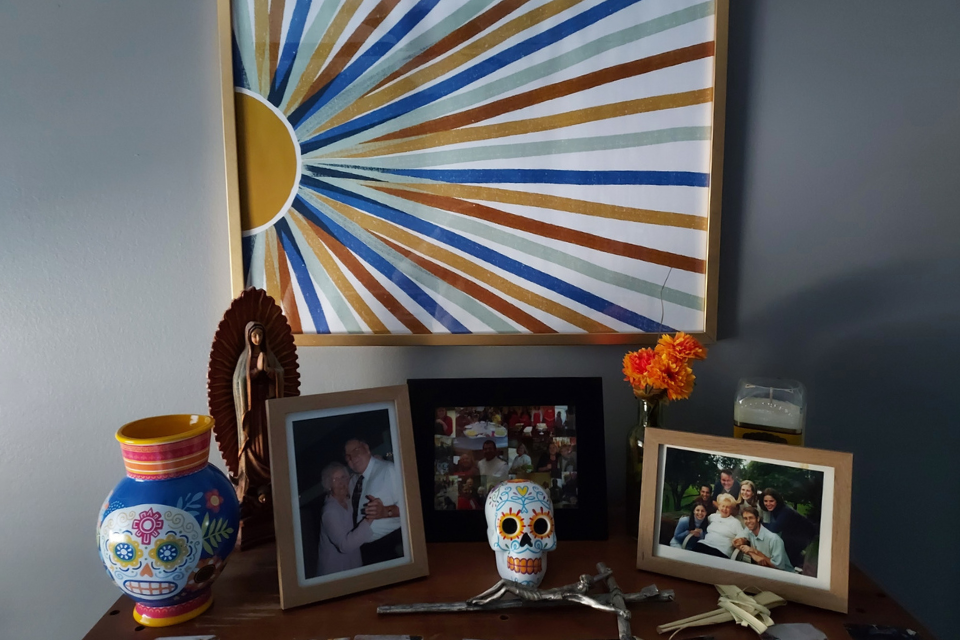The Rev. Paul Perez gives reasons for creating his ofrenda, an altar display rooted in his Mexican heritage, as a way to process loss and grief alongside moments of joy during the past three years.
PAUL PEREZ
Director of Connectional Ministry, Michigan Conference
Last week, I set up my ofrenda.
An ofrenda is an essential part of Dia de los Muertos (Day of the Dead), a celebration originating in Mexico that occurs around the same time as what those of us in the USA call Halloween, All Souls Day, and All Saints Day. Ofrendas are altars, or displays, that honor and remember deceased relatives and loved ones.
Unlike many of the ofrendas you would find in Mexican communities, mine is simple. I assembled it on my office bookshelf. It has pictures of deceased loved ones—my mom, my grandparents, and my wife’s grandma. There is a ceramic replica of the classic “sugar skull,” a small vase with marigolds, a crucifix someone gifted to my wife and me on our wedding day, and a wooden statue of Mary, Nuestra Señora de Guadalupe.
I did not grow up around ofrendas. The Mexican side of my family is largely assimilated into USA’s dominant culture. To be honest, I’ve always felt a bit too Mexican for the Anglos and a bit too Anglo for the Mexicans. However, over the past several years, I found myself drawn to creating an ofrenda. I think the lure is equal parts reconnecting with my Mexican roots and finding ways to process grief. Let me share a couple of experiences to illustrate.
In October 2019, I traveled to the USA/Mexico border to learn about the migrant crisis. It was my first trip to the Texas/Mexico borderlands, where my grandmother’s family lived for generations. The people, the landscape, the food—they all felt familiar in both a comforting and uncanny way. I ended my trip in San Antonio to share my experience with members of the General Board of Church and Society. One evening, after a marathon day of Methodist meetings, a few of us went out for dinner on San Antonio’s Riverwalk and stumbled onto a Dia De Los Muertos celebration. Ofrendas lined the sidewalks. One reverently displayed baby items—a tribute from parents grieving the loss of their infant children. It stopped me in my tracks and moved me to prayerful silence.
In October 2020, my wife picked up the aforementioned ceramic skull and fake marigolds at Target for fall decorations. In the midst of COVID-19, starting a new job, and grieving my grandmother’s death, I felt compelled to create an ofrenda to mark this transition time. I used those decorations to build my first ofrenda atop the upright piano in our living room.
In October 2021, my wife and I took the Friday afternoon before Halloween off and spent a portion of the time taking in the Detroit Institute of Arts. On exhibit were ofrendas created by local artists. They were beautiful, quirky, haunting, and moving—sometimes all at once. Seeing these ofrendas offered me the freedom to make my ofrenda in my own way.
Where Halloween gives our chilling fears and macabre fantasies a playful form, Dia de los Muertos and its ofrendas give our grief a joyful form.
Creating my ofrenda is, for me, a healing and cathartic practice. Building an ofrenda offers a certain physicality, a unique concreteness to the often disembodied realities of death and grief. My ofrenda greets me every morning as I enter my office; it sits just to my left as I engage in my morning prayer. I see it perched over my shoulder as I stare at my Zoom image during the day. I trust in the mysterious promise of eternal life. I have faith that God’s love sustains us beyond death. I hold out hope for the bodily resurrection. Making my ofrenda makes these lofty theological convictions part of my everyday life. It incarnates the presence of my loved ones and my ancestors, and it embodies the resurrection hope of my Christian faith.
I think, for that reason, I needed an ofrenda the past three Octobers—pandemic, 2020’s summer of protest and racial reckoning, the events of January 6, 2021, the war in Ukraine, major life changes, online school, online church, online meetings, delayed General Conferences, the launch of the Global Methodist Church. Even as the day-to-day seems more familiar with fewer COVID-19 restrictions this fall, the world, the church, and our lives are not the same as they were in 2020. Everything has changed.
I think church leaders feel this reality acutely. Churches and faith communities are gathering together face-to-face, in the flesh, but everything has changed. Many folks have not returned, and some may never. Long-standing, core ministries are struggling to find their footing. Other ministries have somewhat unexpectedly found new life. New ministries, forged in COVID-19’s crucible, are emerging. Denominationally, I’ve heard some pundits opine that the pandemic accelerated our decline by five years or more. I think they’re right. As church leaders in 2022, we find ourselves with the task of shepherding a mid-twentieth-century church into a mid-twenty-first-century world. We are in the precarious place of straddling a century, simultaneously holding space to both grieve the church that is passing away and nurture the church that is yet to be.
All of this is another reason this church leader set up his ofrenda last week. Praying that what is forgotten may be found again. Trusting that those departed are never too far away. Hoping that where both death and life, painted skull and wilting marigold, sit side by side, both grief and joy are on full display.
Last Updated on October 18, 2022

